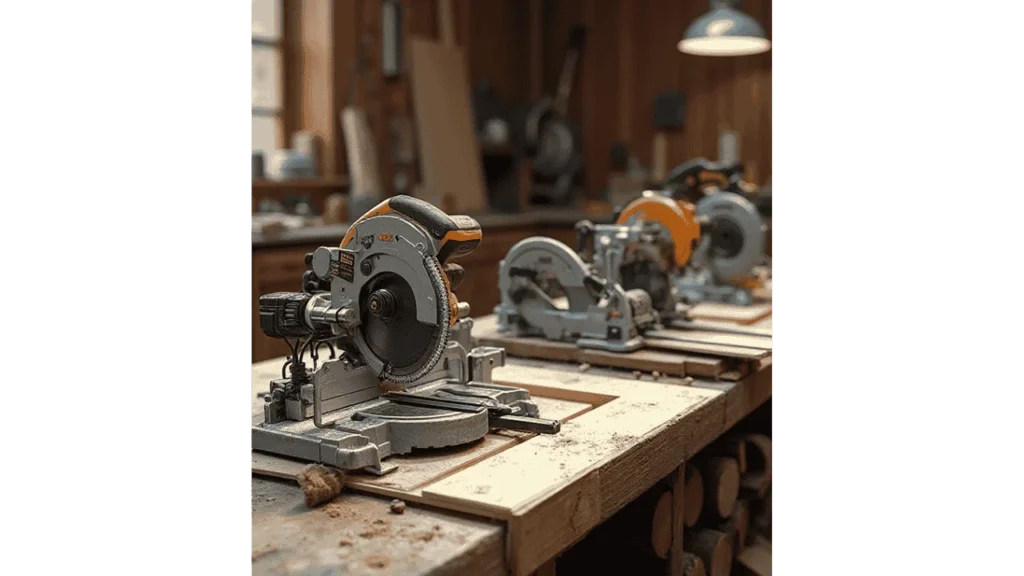Power saws are electrically or gas-powered tools designed to cut through wood and other materials. They offer efficiency, precision, and speed, making them essential for both professionals and DIY enthusiasts. Whether you’re working on a small home project or larger tasks, understanding the different types of power saws can help you select the right tool for your needs.

Common Types of Power Saws
Circular Saw
A circular saw is a versatile handheld tool featuring a toothed blade that rotates around an arbor. It’s one of the most commonly used power saws for general woodcutting.
Circular saws are ideal for making straight cuts in lumber, plywood, and other sheet materials. They come with adjustable depth and bevel settings, allowing you to make various cut types, including angled cuts and deeper cuts.
According to carpenter John K., “Circular saws are an essential tool for most woodworkers because of their adaptability. They’re reliable for both beginners and seasoned pros.”
Miter Saw
A miter saw is a stationary tool designed for precise crosscuts and angled cuts (miters), often used in framing and finishing.
It’s perfect for cutting trim, molding, and framing materials at specific angles. The saw’s rotating blade head allows for angled cuts, and some models feature a sliding function for cutting wider pieces of wood.
Sarah M., a framing contractor, explains, “I use a miter saw regularly for precise trim work, and the sliding feature makes cutting wider boards so much easier.”
Table Saw
The table saw is a stationary saw with a circular blade mounted beneath a table, making it perfect for more precise, controlled cuts.
It excels in ripping large boards, making dado cuts, and performing other precision tasks. The saw includes a fence system for straight cuts, along with adjustable blade height and tilt options for different cutting angles.
Tim S., a woodworking expert, notes, “Table saws are the backbone of any woodshop. They offer incredible accuracy when it comes to ripping wood and making consistent cuts.”
Jigsaw
A jigsaw is a handheld saw that uses a straight, reciprocating blade for cutting wood.
It’s perfect for making curved cuts, intricate patterns, and plunge cuts. Jigsaws often feature variable speed settings and orbital action, allowing for faster cuts in wood and other materials.
Emily R., a home DIYer, shares, “Jigsaws are my go-to tool for cutting complex shapes. They’re easy to use and provide great control over detailed cuts.”
Reciprocating Saw
A reciprocating saw, often referred to as a ‘Sawzall,’ has a push-and-pull motion blade that makes it highly versatile.
It is commonly used for demolition, pruning, and cutting through wood, metal, and plastic. Many models offer tool-free blade changes and an adjustable shoe for depth control, making it convenient for various projects.
Construction worker David P. says, ‘This tool is a must-have for demolition projects. It can cut through almost anything, and the tool-free blade change feature is a huge time-saver.’
Chainsaw
A chainsaw is a portable saw that features a chain running along a guide bar, making it ideal for larger-scale cutting tasks.
It is designed for cutting through trees, large branches, and logs. Chainsaws are available in gas, electric, and battery-powered models, with different bar lengths to accommodate various cutting needs.
Arborist Jack H. notes, “I’ve been using a chainsaw for years, and I appreciate the power and versatility it offers for heavy-duty outdoor work.”
Band Saw
The band saw is a stationary saw with a continuous loop blade running over two wheels, making it an excellent choice for cutting curves and resawing.
It is ideal for cutting curves, resawing lumber, and making straight cuts in thicker materials. Band saws allow for adjustable blade tension and come with various blade widths, providing flexibility in cutting different materials.
Woodworker Chris D. explains, “The band saw is great for cutting both intricate curves and straight lines in thicker wood. It’s a very adaptable tool for fine woodworking.”
Scroll Saw
A scroll saw is a stationary tool with a fine, reciprocating blade, designed for detailed cutting.
It is perfect for intricate and detailed cuts, such as patterns and designs. Scroll saws come with variable speed control and a tilting table for making bevel cuts.
Woodworker Linda F. says, “If you’re doing fine, detailed work, a scroll saw is the best option. It’s ideal for cutting small, complex patterns that require precision.”
Choosing the Right Power Saw
Selecting the right power saw depends on the nature of your project. For framing and rough cuts, a circular or miter saw would be appropriate, while for more detailed work, a jigsaw or scroll saw might be better suited.
The material you’re working with also plays a crucial role, certain saws are better for cutting specific types of wood or other materials. Handheld saws are ideal for smaller, more maneuverable projects, while stationary saws offer greater stability for more precise cuts.
Finally, your budget will also influence the saw you select. Higher-end models often come with more advanced features but will cost more. Weighing these factors will help you pick the perfect saw for your needs.
Final Takeaways
Different power saws serve different purposes: Circular and reciprocating saws are great for general tasks and offer broad. Miter and table saws are ideal for projects requiring accuracy and clean cuts. Jigsaws and scroll saws are the go-to tools for detailed, curved cuts. Chainsaws and band saws are suited for larger, more demanding cutting projects.
- How to Cut a Straight Line with a Jigsaw? - October 31, 2025
- How to Cut a Circle with a Jigsaw? - October 31, 2025
- Can You Cut Acrylic with a Jigsaw? - October 31, 2025
